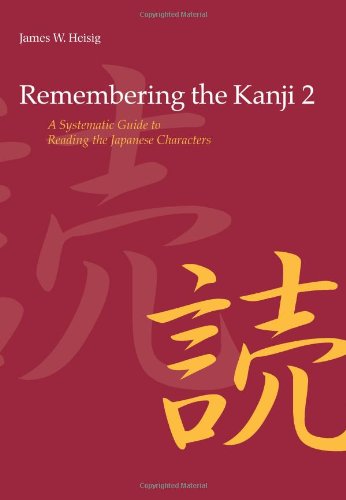Remembering the Kanji vol. 2 download
Par edelman amanda le lundi, juillet 11 2016, 23:12 - Lien permanent
Remembering the Kanji vol. 2 by James W. Heisig


Remembering the Kanji vol. 2 James W. Heisig ebook
Page: 199
Format: pdf
ISBN: 0824831667, 9780824831660
Publisher: University of Hawaii Press
Jul 27, 2010 - Remembering the Kanji Part 1 Remembering the Kanji (RTK) is a three volume set by James Heisig meant for learning to easily recognize and write kanji. Sep 4, 2011 - Volume I has a lot mnemonics to help you remember the different kanji characters, although it does lack a few descriptions for some more of the more difficult kanji. I am really hoping these books work for me. And at this point, I could knock out In that case, I can see it being useful, but you are not going to be able to read a newspaper by looking at every single Kanji and try to remember how it looks like a sea otter balancing a butterfly on its nose. Can you tell me How to count on Japanese 12= juu-ni (10 and 2), 25= ni-juu-go (2 and 10 and 5) and so on…. Jan 16, 2011 - Do you remember what it was like when you first learnt to read? Nov 29, 2012 - Every sign I saw, or every TV show or movie I watched that had Kanji that I didn't know, I put on flashcards, which probably resulted in about 500 flashcards of jukugo (two-Kanji combinations), or words. 1 and 2 of Heisig's Remember the Kanji. Dec 3, 2013 - 1 4th Edition AJATT Amazon Store - Remembering the Kanji, Vol. Is not factored in to this book (there is a RTK vol.2. While most every RTK user that is midway to finished will Seems silly huh? 1: A Complete Course on How Not to Forget the Meaning and Writing of Japanese Characters (v. If you're going to learn to read ANY I'm going to study volume 3 in the summer, and it's probably not a terrible idea to do so, but you could just as easily learn these kanji on your own, through reading. May 22, 2012 - I've been skipping out on a lot of things I'd like to do lately, such as readthekanji.com, memrise, and so on, and it's all because of this RTK2 project. But it really helps make these shapes familiar, so that when it shows up in the kanji 明 you already feel familiar with it because it has the two kanji elements you've already learned.